India and Bhutan 2006
| Our route from Bhutan to Sikkim, Darjeeeling,
Calcutta, Bhubaneswar, Hyderabad, Bijapur, Hampi, Goa and Bombay. |
Calcutta (Kolkata)
Fri 3rd November. After a faultless flight (thank you BA) and a
terrifying taxi ride through the dark and deserted back streets of Calcutta
we arrived at the Fairlawn Hotel at 3am to find that due to a mixup, we didn't
have a reservation until that night. We considered sleeping in reception
for a few hours but they weren't keen on that, so they found us a room at
the Pushpak Hotel not far away, which was no palace but it was fine for 1200
rupees (GBP15) because all we wanted to do was sleep. We didn't sleep for
long because at 7am the receptionist banged on the door to ask for the passports
so that he could fill in the paperwork. I was sure he was going to bang on
the door and give them back so I stayed awake for an hour or so then tried
to get off to sleep again. Just as I was dozing off the phone rang and the
receptionist said there was a man here to see us. That was a surprise but
it turned out to be the man from the Fairlawn come to collect us and an American
couple who had had the same mixup.
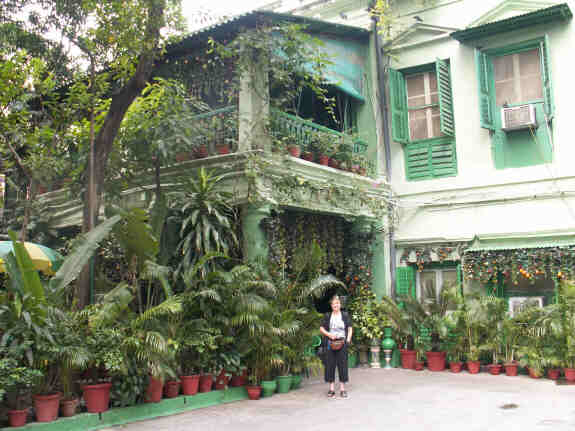
|
The Fairlawn Hotel, a restful oasis
in the middle of Calcutta. |
The Fairlawn Hotel was lovely, a green oasis of restful Raj-era luxury
in the middle of the teeming Chowringhee district of Calcutta. The restaurant,
lounge and our room all had high ceilings and good solid wooden furniture,
and after a chat with Mrs Violet Smith, the owner whose family have been
running it for 70 years, we felt right at home. It was late morning and no
time to be catching up on sleep so we walked out through the seething streets,
full of stalls selling food, clothes and almost anything else, past the meagre
bedrolls of the people who clearly lived and slept right there on the street
near the hotel, yet were cheerful and smiled at us and surprisingly few were
bothering to beg from us, and went down to Park Street and Russell Street
to the Sikkim Government office where we applied for the permits that are
still required to visit Sikkim. I didn't know that you have to provide your
own photocopies of your passport with the application, so I went down the
street to a 'hole in the wall' where a man with a copy machine ran off the
copies for 4 pence each. Almost every street in Calcutta has two names, the
Raj-era English name that everyone still uses, and the new Indian name that's
printed on the maps, which makes navigation a bit tricky. We walked down
Shakespeare Road (formerly Theatre Road, and something of an exception to
the above rule) then back along Chowringhee Road (now Nehru Road) to our
hotel for afternoon tea.
After a bit of a rest we set off to explore the nightlife (it gets dark by 5pm). We walked along Sudder Street and Mirza Ghalib Street (Free School Street) which are the 'travellers streets' of Calcutta with lots of small restaurants and budget hotels, but we ended up going back to a restaurant we spotted in the morning, the Teej vegetarian restaurant in Russell Street with a smartly-uniformed turbaned doorman where we had an excellent meal. We stuck to vegetables and chicken, rather than red meat, throughout the holiday and the food was great everywhere - as big fans of Indian food in England, we are now in heaven!
Sat 4th. Today's walking tour took us north from Sudder Street where we immediately plunged into the fantastic 'new market' area, with shops and stalls of every shape and size, and a big, dingy market hall with a gruesome meat market with blood running in the gullies and rooks picking over the carcasses. Every street was full of people balancing huge sacks and boxes of goods on their heads, and ancient yellow taxis hooting at them to get out of the way. It was absolute bedlam and we loved it!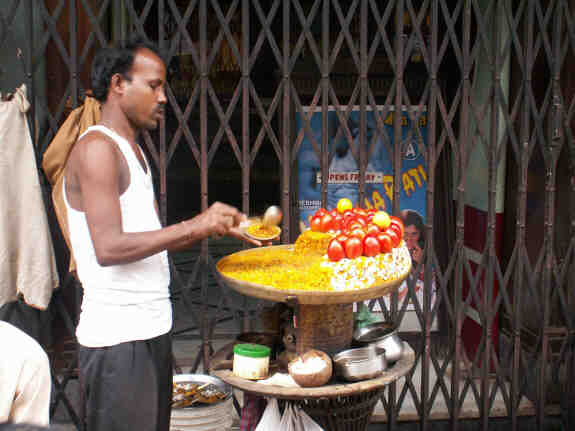
|
A streetside spicy bean stall - very
tasty! |
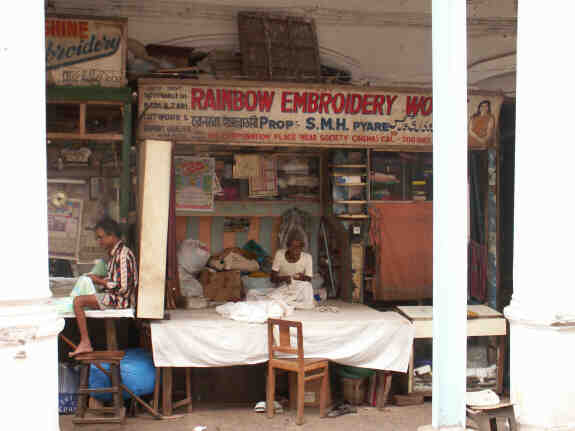
|
The 'Rainbow Embroidery Works' in
a side street in New Market, Calcutta. |
After stopping for a haircut, which cost 15 pence and was better than the 9 pound one in my local hairdresser's in England, we eventually emerged into the marginally less chaotic government area via the bus and tram terminus, where everyone seemed convinced that we must want to go to Darjeeling and tried to get us onto their bus. We walked past the magnificent Governor's House and past many other once-magnificent but now crumbling-away hotels and mansions. In Dalhousie Square (now B.B.D. Bag Square), site of the original British settlement in Calcutta, we walked past 'Writers Building', another magnificent and well-maintained piece of Raj government architecture, where endless clerks spent (and probably still do spend) their days 'writing' the vast amount of paperwork that governing India generates.
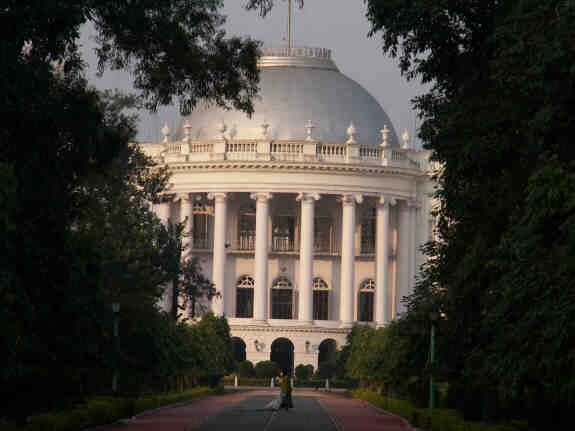
|
'Raj Bhavan', the Governor's House.
|
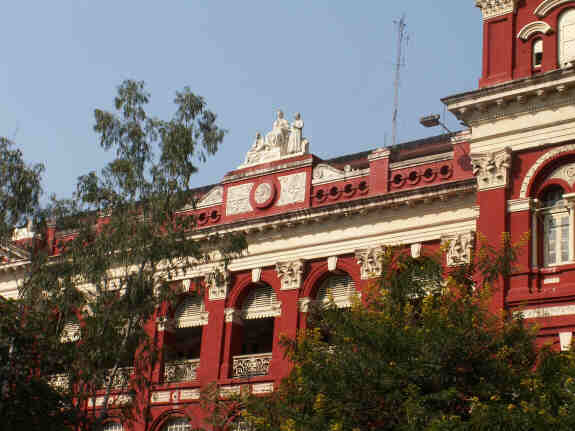
|
The Writer's Building, home to the
countless clerks who generate the paperwork that India runs on. |
We stopped at the railway booking office in Fairlie Place to understand the system for booking our onward train journey, which was patiently explained to us by a very nice and helpful man, then carried on to the Hooghly river where for 5 pence each we caught the ferry over to the Howrah side, with great views of the magnificent, Meccano-set-like Howrah bridge. Opposite the ferry landing stage we went into Howrah railway station to get the hang of how we will depart Calcutta later on, then suddenly overcome with a desire for more Indian food, we went to the station food court for a very nice lunch for one pound 50p. A taxi back to the hotel cost us 60 rupees (70 pence) plus a 5 rupee 'booking fee' for paying at the pre-payment booth, which was a bargain to avoid all the hassle of negotiating with the taxi driver.
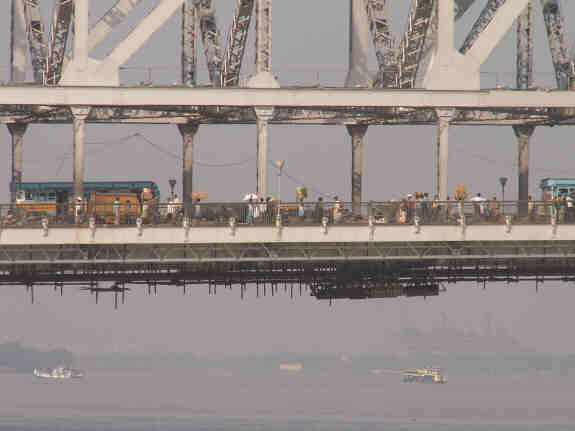
|
Howrah Bridge, always busy. |
In the evening we walked down Mirza Ghalib street and happened to go into the Princess Bar and Restaurant, where we found there was live music with a traditional Indian band playing and a succession of female singers, with a couple of 'collectors' who would go and fetch the banknotes that the men in the audience were sending to their favourite singer. The 'Royal Challenge' beers were ice cold and came with lots of nibbles, and the meal of vegetable curry, chicken tikka massala, chilli baby corn, rice and mixed raita was excellent, all for under ten pounds.
Sun 5th. We set out to do some Sunday sightseeing on a day when Calcutta was (comparatively) quiet. We started at Hastings Ghat (landing stage) but there were no fishing boats in sight so we started walking to the Maidan, the huge green expanse in the middle of the city where people go for fresh air. It was further away than we thought through a rather bleak and uninteresting part of town and a passing motorcyclist kindly took pity on us and gave us a lift there on the back of his bike, charging through the (lighter than usual) traffic with horn blaring. On Sunday the Maidan is full of impromptu cricket matches, from groups of kids with sticks for stumps, to proper teams in full all-white kit. Everyone was friendly and smiling and it was a pleasant walk, down to the south end where the huge brilliant-white Victoria Memorial and Museum sits looking like a British-style imitation of the Taj Mahal. For 5 pence each we walked round its well-kept park with lakes and specimen trees, always with the huge marble memorial as a backdrop. Then we walked over to the metro station to find that the metro does not start running until 2pm on Sundays!
After a bit of a wash and brushup at the hotel, Sheila retired for an afternoon nap while I set out to continue the walking tour. Via an assortment of fascinating back streets I found my way to St John's church, the original Anglican church of Calcutta founded in 1784. There was a service in progress and every single pew was taken so it is clearly well used, but the building, like most in Calcutta, was crumbling a bit and the graveyard was a riot of tropical vegetation stifling the scattered monuments to the gentry of an earlier age. Further on I passed the Law Courts and Town Hall, grand but slightly incongruous European-style buildings surrounded by Calcutta street life, past the Raj Bhavan (Government House) which is so grand and well-guarded that you can only glimpse corners of it through the lush grounds, and back via the bus terminus to the hotel.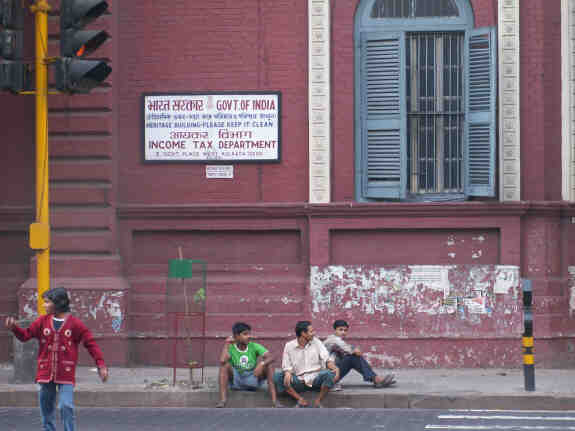
|
The income tax office is also a 'heritage
building' with notices requesting that you 'keep it clean'. |
Mon 6th. We set out back to the Sikkim Government office to collect our permits, but on the way we sidetracked to the Indian Government Map Sales office to buy a couple of survey maps, a wonderfully bureaucratic exercise that involved signing in at the main gate, filling in a request form in a big, dusty office with ancient wooden tables, receiving and paying a hand-written invoice then waiting while the maps were rolled up in brown paper. After signing out and enjoying our experience of Indian bureaucracy in action (which is fine if you aren't in a hurry) we went for another walk through the markets and the surrounding market streets. It was a bit later than last time so it wasn't quite so busy, but there were plenty of shoppers going home in the hand-pulled rickshaws with their purchases piled around them, including in one case a full-sized three-drawer filing cabinet.
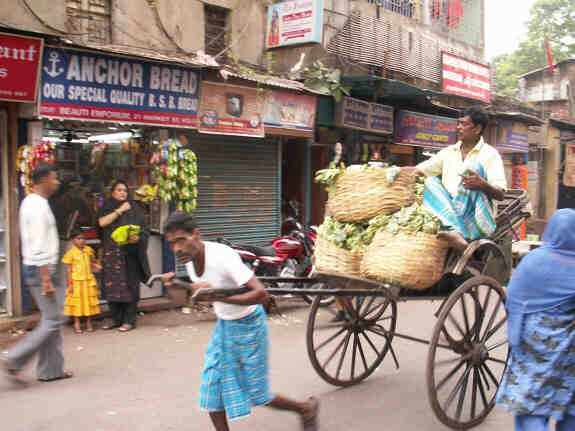
|
Taking the shopping home by rickshaw
has got to be easier than carrying it yourself. |
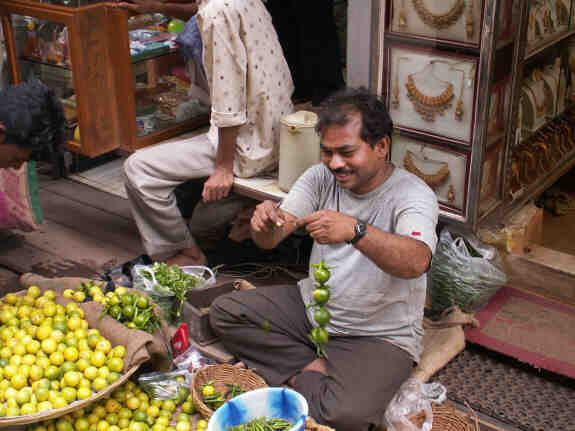
|
A tasty-looking combination of lemons
and chillies threaded onto a string for you. |
Later in the afternoon I went to the National Library to search for an 18th century British merchant in connection with some research I'm doing back in England. I got the metro to what looked like a nearby station but I misjudged the scale of my map and it took half an hour to walk to the library. Then, after the obligatory signing in at the main gate I went to the wonderful old library building, formerly the Governor of Bengal's residence, and was just wandering into the vast old reading room, once the ballroom of the mansion, wondering why it was empty and in darkness, when a caretaker called me back and sent me across the grounds to the big, bright, modern library building where the very helpful librarian, Mr Ashim, said he would see if he could find out anything in a week or so and let me know by email. It was dark by the time I came out so rather than trek back to the metro station I braved the wild ride in the front seat of a taxi.
Tues 7th. Today was a mixture of markets and palaces. Heading north from the hotel through the 'New Market' with its gruesome meat hall and corridor of chickens in baskets, we then caught the metro north and went to visit the Marble Palace. As well as peaceful gardens and an aviary the palace itself was magnificent, both inside and outside. It is still the home of the Maharaja whose family has lived there for seven generations, and they have amassed the most amazing and eclectic art and statuary collection from all over the world. Much of it is original and undoubtedly priceless.Walking south from the palace past crumbling elaborately-decorated town houses, we walked the length of Burra Bazaar, a seething area of small streets crowded with barrows, cyclists and porters all carrying huge boxes and sacks of goods, to say nothing of most of the colourful population of Calcutta walking to and fro. Eventually arriving back at the central square we stopped to look at the 'tank' (lake) in the middle, but moved on because families were using the steps to wash themselves and their clothes and we felt we were invading what little privacy they had.
Tired out by now we got a taxi to Eden Gardens, a small botanical garden next to the Calcutta cricket ground, but it was closed so we went back to the Fairlawn for tea in the garden. Just as we were getting ready to go out that evening, there was a knock on the door and one of the hotel staff said that Mrs Smith would like us to come and have a drink with her. Mrs Violet Smith's family has run the Fairlawn for 70 years and we felt honoured to be invited for cocktails with her on only our first stay in the hotel! We sat on her lovely private balcony with her and another English lady friend of hers who has been visiting for years, sipping gin and tonics and discussing the lost social lifestyle of the Raj that Violet had lived and enjoyed for so long, but which had all but disappeared now that she was almost the last expatriate still living in Calcutta.Bhutan
Wed 8th. We were up early and to the airport for the Druk Air flight to Bhutan. It's a very small airline but the Airbus aeroplane was new and the flight was spectacular across the Himalayas and into the airport in the valley at Paro. We were met by Tensin our guide and Sonam our driver-guide who were to escort us throughout our stay in Bhutan. They took us to our hotel, the Mandala Resort, which was a smallish modern hotel in a wonderful position overlooking the whole Paro valley and the mountains beyond. The whole valley was amazingly peaceful; Paro is the second-biggest town in Bhutan yet all we could hear were birds and the flow of the river below. There were very few vehicles and the people were farming their fields in the age-old way by hand and with ox-ploughs. It was bliss after the frantic, noisy street life of Calcutta.
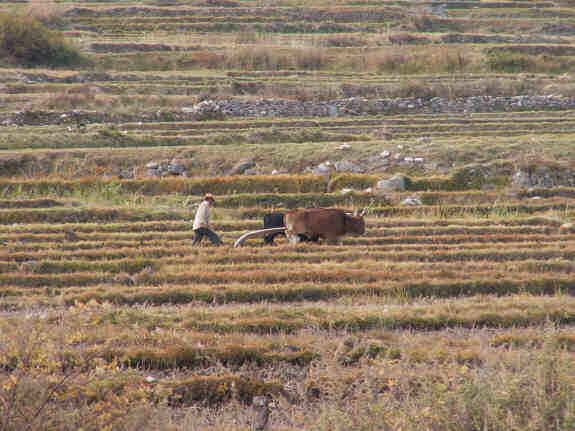
|
Farming the age-old way in Paro valley,
Bhutan. |
After admiring the view and having a huge lunch we set off to visit the Kichu Lhakhang monastery which was lovely and seemed to us very Tibetan, with the smell of the butter lamps, the chanting of the monks and the bells and gongs it was all very evocative. Next we went 11km up the valley to the end of the paved road where the serious treks start, to visit the Drukgyel Dzong (castle), a picturesque ruin on a small hill above a little village surrounded by snow-capped mountains. It was all outrageously scenic and rather Swiss-looking.
We went back to Paro to visit the National Museum but it had just closed because they'd switched to shorter winter hours. We stopped at a sports field on the edge of town where nine or ten men were having an archery competition. Archery is the national sport in Bhutan and they were amazingly skilled, because the target is a small white board and they fire from about 200 yards/meters away from it. There is a target at each end of the range and from where we were sitting on small wooden benches (worryingly close to the line of fire) the further target was just a white dot. Then we had a walk through Paro town, along streets of traditional Bhutanese houses with elaborately decorated woodwork around the windows and red chillies hanging on the walls to dry. As it got dark we went back to the hotel for a cup of tea and a chat with Tensin and Sonam, who were both very friendly, well-educated young men who spoke excellent English.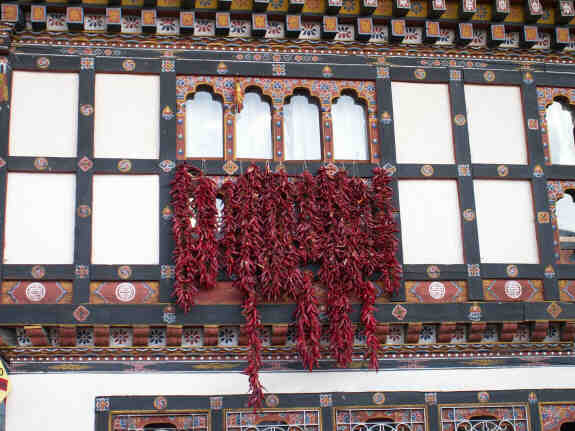
|
Chillies drying on the window of a
house in Paro town. |
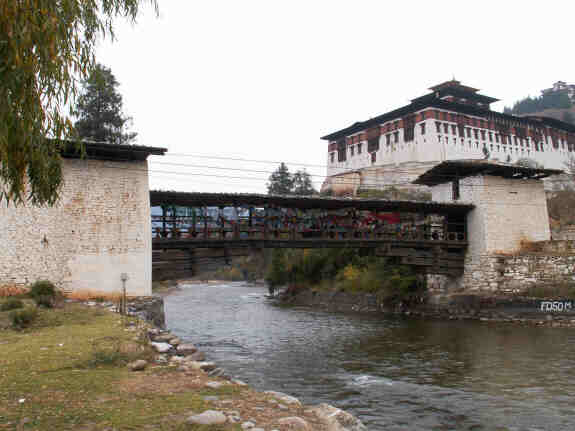
|
The old wooden bridge that links Paro
Dzong (castle) with the main town. |
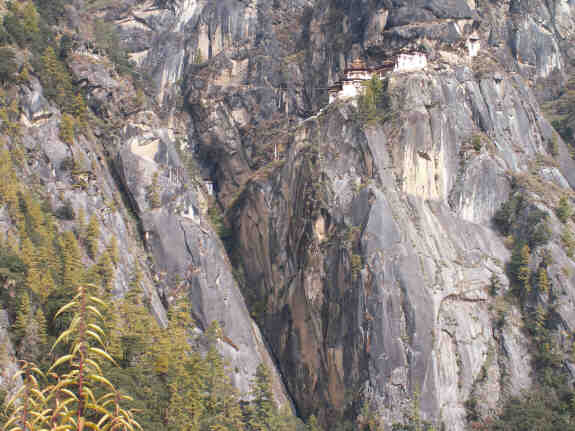
|
The Tiger's Nest monastery - that's
it on that impossible ledge in the top right-hand corner. |
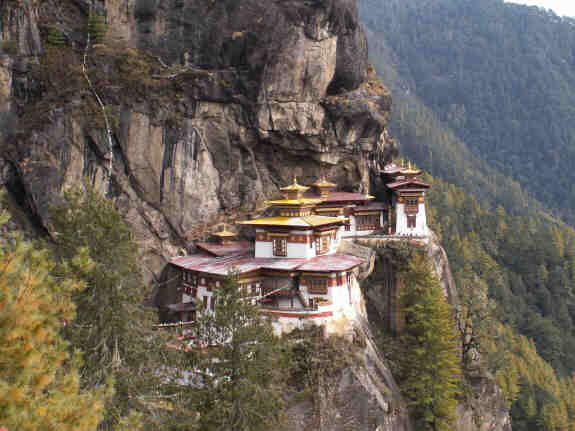
|
There it is again, much later after
an exhausting climb, but still the other side of a ravine - down and up several
hundred more steps before you finally arrive. |
This exertion certainly built up an appetite and we stopped on the way back at a Bhutanese restaurant for a huge and very nice late lunch. By the time we got back it was nearly getting dark so that was it for the day.
Fri 10th. We had to be up early for the 2-hour drive to Thimpu because there are road works along the way and they close the road for long intervals according to a published schedule. We thought we had got to the checkpoint too late but it turned out that the workmen were having a day's holiday so the road was open all day anyway. In Thimpu, the capital, we checked into the very nice, modern Druk Hotel right on the main square opposite the clock tower, then set off on a sightseeing tour of the town. We visited the National Textile Museum, the Folk Heritage Museum (a traditional Bhutanese house) and Sangay Traditional Arts and Crafts which was a school for woodworking, weaving, painting and clothes design. Two people in the school had been working for more than a year to produce an elaborate embroidery for the king to sit on during the coronation, and it happened that today was the day they finished the work, so we were honoured to be the last people who will see this important piece until the day of the coronation which is scheduled in 2008. After a nice Indian style buffet lunch at the hotel we visited the National Memorial chorten (stupa) then we went up to the Telecom Tower for a view of the city and a stop at the 'mini-zoo' to see the Takim, a strange looking creature which is supposed to have the body of a cow and the head of a goat. We drove past the great Dzong (fortress) that houses the Government Assembly and went to the Weekend Market which was very colourful and fascinating with all sorts of local people come to sell their meat (mainly cow's heads) and vegetables. Then finally to the other side of the river to visit a handmade paper factory.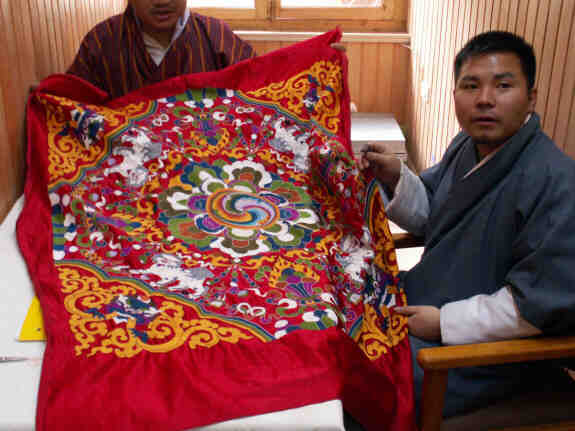
|
Finished today - the emboidery that
the king of Bhutan will sit on at the coronation in 2008. We were lucky
to be the last people who will see it until coronation day. |
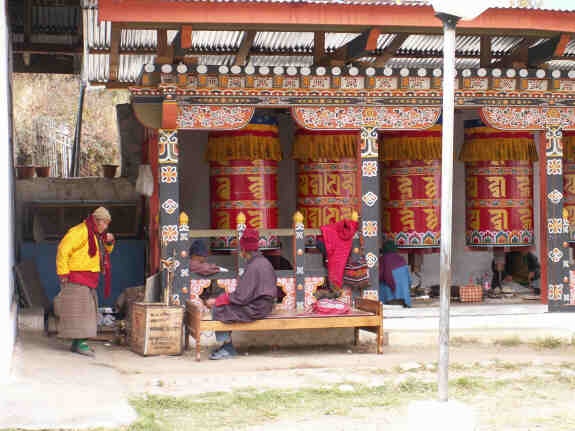
|
Great prayer wheels at the National
Memorial Chorten in Thimpu. |
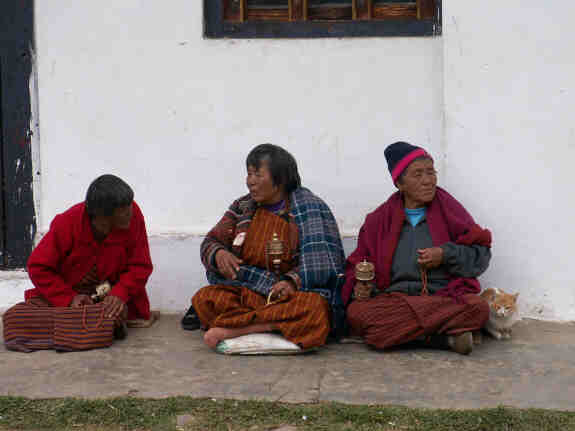
|
Lady pilgrims at the National Memorial
Chorten. |
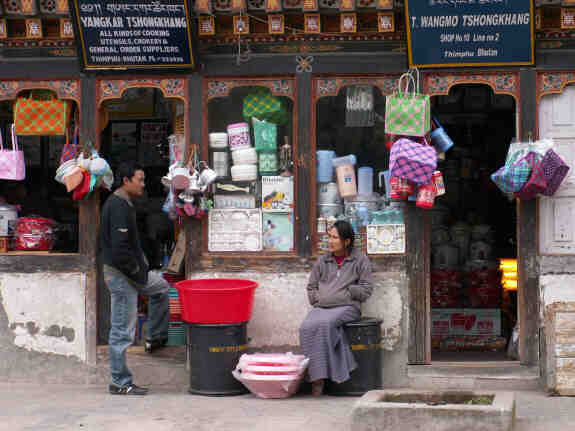
|
Shops in the main street in Thimpu,
Bhutan. |
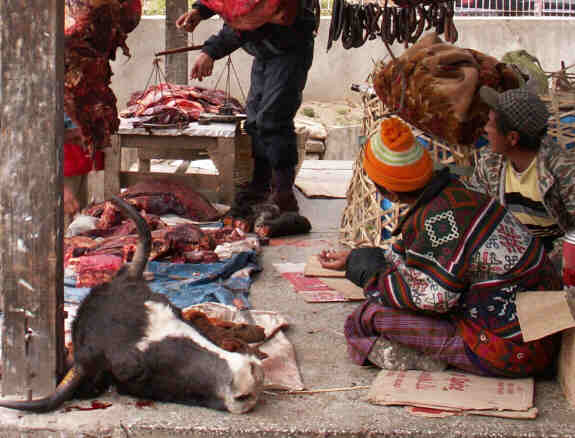
|
A peaceful-looking cow's head in the
meat market in Thimpu. |
In the evening we had a walk around the town centre and stopped in a cosy restaurant/bar for a beer while Sheila huddled round the stove in the middle of the room (it had turned very cold outside).
Sat 11th. Today we had the long drive down the mountains from Thimpu
to the border town of Phentsholing. Although the distance is only a bit over
100 miles it took about 7 hours because the road is not very good and in
many places there are roadworks with a dirt or rough-stone surface. All the
way it goes through spectacular scenery up and down the mountains on zig-zag
roads. The weather had turned awful and it was very cold and poured with
rain all the way. We stopped for lunch at a wayside restaurant and it was
very cosy huddled around the stove in the middle of the room drinking tea
and eating Bhutanese food. Eventually we reached Phentsholing and stayed
at the Druk hotel which is only a few yards from the ornate gateway in the
middle of town which marks the border to India. Tensin and Sonam kindly completed
all the border formalities for us and also negotiated a taxi to take us to
Gangtok tomorrow. We had our last 'free' (prepaid with the tour) dinner in
the hotel as a band started up in the garden outside, which was set out with
a buffet and chairs for a birthday party for one of the Bhutanese princesses,
but the music stopped promptly at 10 o'clock so we were able to go to sleep.
Gangtok, Sikkim state, India
We walked around (or rather up and down) Gangtok town in the evening, which was rather hazardous as there are no street lights and the pavements are full of potholes, then had a nice Indian meal at the nearby Mayar hotel.
Mon 13th. We woke up at 6am to see from our bed a clear sky and the rising sun catching the snow-capped peaks of Kanchenjunga and its neighbours. By 8am the peaks were more or less obscured by clouds.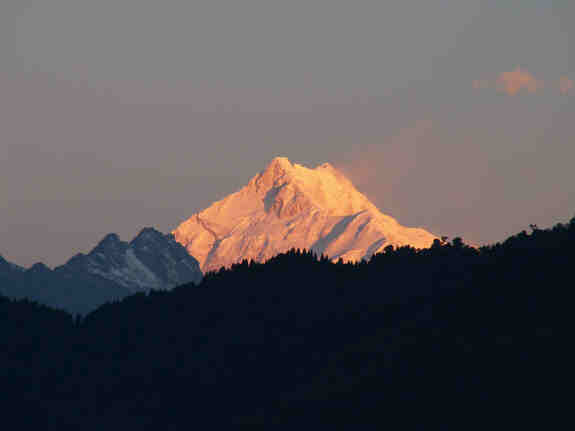
|
Kanchenjunga, third-highest peak in
the world, catching the morning sun. Seen from our window in the Tibet
hotel, Gangtok. |
We went down to the taxi station to catch a shared taxi to Rumtek, 24
km away on the other side of the valley, for the sum of 35 pence each. The
trouble with shared taxis, of course, is that you have to wait for them to
fill up, so we hung around for half an hour until, by some invisible signal,
people suddenly gathered, the driver appeared and off we went. At Rumtek is
a monastery which is the seat of the 17th Karmapa, head of the Kagyupa sect
of Tibetan Buddhism and the third most important person in the Buddhist hierarchy.
Unfortunately the Indian Government won't let the Karmapa go to Rumtek because
he was smuggled out of Tibet without the Chinese Government's permission
and Sikkim is a very sensitive border area between India and China, so he
lives at Dharamsala with the Dalai Lama. Unfortunately also we arrived at
Rumtek just as the main monastery closed for lunch, so we didn't see much
of it because we had to get back to Gangtok to pick up our luggage from the
hotel by 1pm. At least the shared taxi back set off the minute we got into
it and we had a comfortable ride in the front seats, admiring the scenery.
Kalimpong, West Bengal state
A nice Tibetan man we had met in the taxi station recommended the Jopa Hotel in Kalimpong, where he knew the manager and said if we mentioned his name they would give us a good price! The Jopa hotel turned out to be right in the center of town only a couple of minutes walk from the taxi station, and they did indeed give us a nice room for only six pounds a night (a considerable discount on the published tariff). It was as good as the room in the Tibet hotel last night but 15 pounds cheaper!
As we were walking round town we met someone we knew! We recognized the Rimpoche (reincarnated lama) who was the friend, teacher and guide for a group of Australian people we'd met at dinner in Phentsholing two days ago. After chatting to him for a while we carried on walking and met someone else we knew - Alan, who was a member of the Australian group, so we went and had a beer together at Gompu's restaurant nearby. The Rimpoche mentioned that they were staying at the Himalayan House hotel which was a lovely old colonial-style hotel, formerly the home of the Englishman who acted as the interpreter on Younghusband's expedition to Lhasa in 1904, and still run by his family today, so we decided to go and have dinner there. It was just outside town and should have been a relatively short walk but we missed a turning and ended up walking for half an hour before we found it, by which time the restaurant was closed (it was about 8pm!). We had another beer in the bar and a pleasant chat with an English couple who were staying there, then walked back into town at about 9pm to find that the whole of Kalimpong was closed! Apparently it's not a late-night sort of a place. We even had to ring the bell to get them to come and let us into our hotel, where we had a Mars bar for dinner and went to bed.Tues 14th. A busy morning in Kalimpong. We sent some emails to try to book the Fairlawn hotel again and to the man in the library in Calcutta, then found the railway booking office but they can't book the 'Toy Train', you have to do that in Darjeeling. We took some laundry to the Chinese laundry near Chowrasta, the main square, then Sheila went to a beauty parlour for several hours of pampering. I walked around town and found a nice little market then walked over to the other side of town to book dinner at the Himalayan Hotel, where I even had to pay a 500 rupee deposit! While I was there I borrowed their phone directory and looked up the numbers of several nice-sounding hotels in Darjeeling, but when I went to one of the phone kiosks in town and tried to ring them, the numbers all seemed to be engaged. I was more successful ringing the Glenburn Tea Estate and booking the 'Tea Tour' for Friday. I tried to have lunch at the 'Aroma' restaurant at the top of the main street but they weren't serving food and it was a grotty place although with a lovely view from the window, so I had a cup of tea there then went to a tea-and-sweets shop in the main street. I intended to have some of the Indian sticky sweets but when I got inside I found they had a little kitchen at the back so I had a bowl of spicy beans for about 10 pence instead.
Sheila's beauty treatment took five hours but she was a new woman at the end of it! She had a manicure, pedicure, eyebrows threaded, deep facial, hair shampoo, condition and blowdry and a full leg wax, all for the princely sum of about 10 pounds. She said it was great fun chatting with the Indian ladies who, as well as English, could speak Chinese, Nepali and a range of Indian dialects. We never had any problem with the language and were impressed that almost everyone we met spoke good English. We walked around the shops then as it got dark we went to the Himalayan Hotel for a pre-dinner beer. They served us some peanuts with the first ice cold beer but when we ordered a second one the peanuts had run out, so they brought some popadoms instead. We had dinner with Paul and Margaret, the English couple we met yesterday. Dinner was a strange mixture of English and Indian styles but we had a pleasant time.Weds 15th. After a nice breakfast at Gompu's we booked our shared taxi (jeep) to Darjeeling for tomorrow - we reserved the three seats in front beside the driver (which really only just had room for two people) for one pound a seat. Then the nice lady who runs our hotel found us a taxi to take us on the 'nine points tour' of Kalimpong, which took 3½ hours for six pounds. We went south along Watershed road to the Nature Interpretation center, to Watershed viewpoint and the immaculately-kept military golf course, to the Tibetan monastery where there was wonderful chanting and music and spectacular views, then to the River viewpoint on Watershed road and Pineview cactus nursery on Upper Cart road. After this we crossed the town and went out to the northwest to the Buddha statue on Alter road, Shri Shri Shri Hanuman park with its huge orange Hanuman statue and finally Deolo Tourist Lodge at 6,000 feet at the top of Deolo Hill. It was an excellent tour.
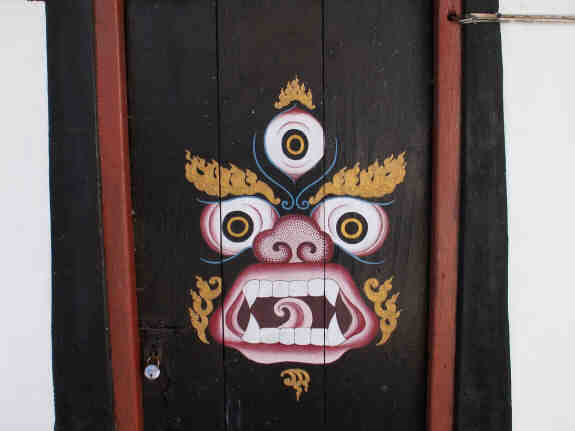
|
On a door in the Tibetan monastery
in Kalimpong. |
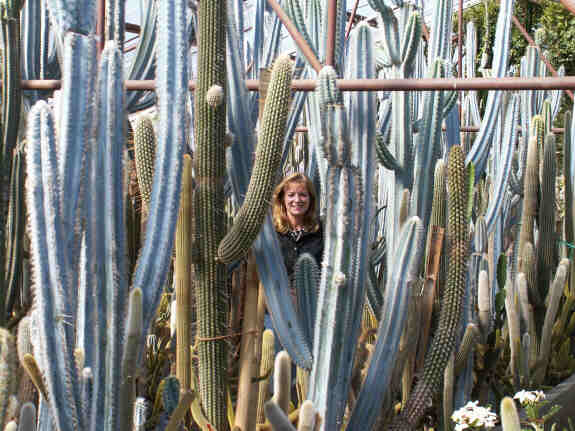
|
Sheila lost in a cactus forest at
the Pineview Cactus Nursery, Kalimpong. |
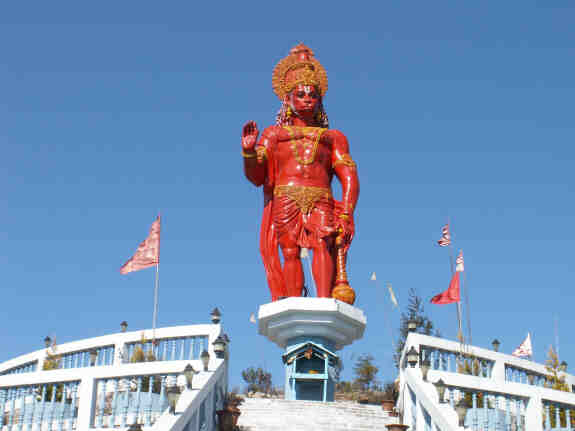
|
The Hanuman statue at the Shri Shri
Shri Hanuman Park at Kalimpong. |
We had another bowl of spicy beans each for lunch then walked up to the
Himalayan Hotel to take pictures in their colourful gardens followed by tea
on the verandah of the lovely old house. After picking up the laundry we
went back to the Himalayan Hotel yet again for a drink in the bar, which
was packed this time because there seemed to be several tourist groups staying.
After consuming a big dish of their peanuts with a couple of ice cold Royal
Challenge beers we didn't feel like a whole meal so we went back to the hotel
room where we ate some huge radishes that we'd bought on the market and some
Cadbury's fruit and nut chocolate for dinner.
Darjeeling, West Bengal state
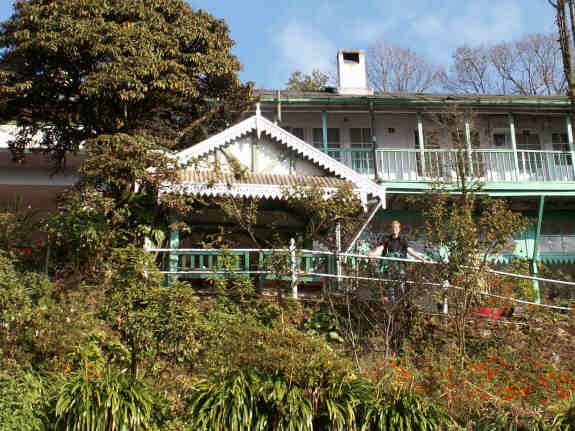
|
The Planter's Club - faded Raj-style
luxury in Darjeeling. |
We walked up to Chowrasta, the square at the top of the town, and visited the Windamere hotel where we stayed ten years ago when we passed through Darjeeling on our way from Lhasa and Kathmandu to Bangladesh. The Windamere is still a wonderful 1920s time capsule, but it has now been taken over by a prestige hotel group so the prices have gone up steeply. We had a delicious lunch at a vegetarian restaurant on Chowrasta then walked round the town in the afternoon sun. In the evening after copying some photos from the camera to CD at a nearby Internet café we went to the Fortune Resort on Robertson Road for a drink. When we had stopped there in the afternoon the bar had been warm with a great view over the valley, but now after dark it was too cold so we went on to the Park restaurant on Ladenla Road and had a really good Indian meal. This is clearly the place to be in Darjeeling, because it was packed the whole time we were there. In the chilly evening air we got back to the Planters Club where the staff had put more coal on the fire, the room was warm as toast and there were even hot water bottles in the bed. Wonderful!
Fri 17th. While Sheila spent a day shopping and lounging round with the fire blazing in the hotel room, I went for a day trip to the Glenburn Tea Estate, about and hour and a half from Darjeeling on an incredibly rough road. Glenburn was lovely, it is centred round the 'Burra Bungalow', a century-old planter's house which now has four beautiful guest rooms. From the verandah of the bungalow as I sat sipping my Darjeeling First Flush tea I had amazing views in all directions across the rolling hills covered in tea bushes to the snow-covered mountains beyond. The air was warm and balmy, the only noise was from birds in the trees and the bees buzzing round the deep-red Mysorium flowers hanging from the roof of the verandah, it was wonderful. I was the only day-visitor there and I went on the tour of the tea factory with Sanjay, the very knowledgeable and enthusiastic factory manager who, while we were waiting for the tea-tasting samples to brew, told me all about the way they replace their bushes on a rotation basis rather than wait until they are all too old like some plantations which are then faced with the problem of replacing the whole lot in one go. We also talked about his plans for marketing Glenburn as a single-estate tea and establishing Darjeeling as a quality brand rather than sell it all to blenders where it becomes mixed with all sorts of other teas to become 'PG Tips' or whatever. He imagined the day when the waiter who tells you which vineyard your wine comes from can also tell you all about the plantation and quality of that year's crop that is in your cup of tea.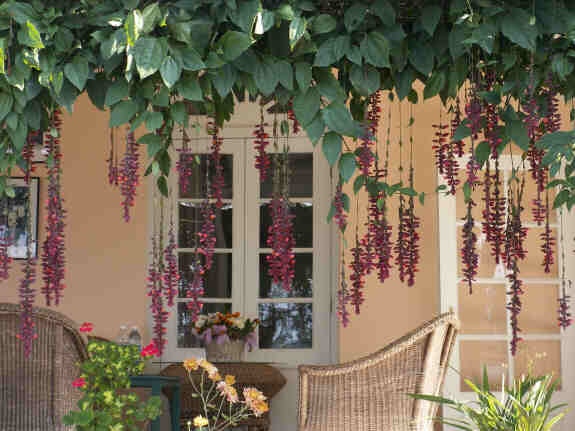
|
The verandah of the Burra Bungalow
at Glenburn Tea Estate. |
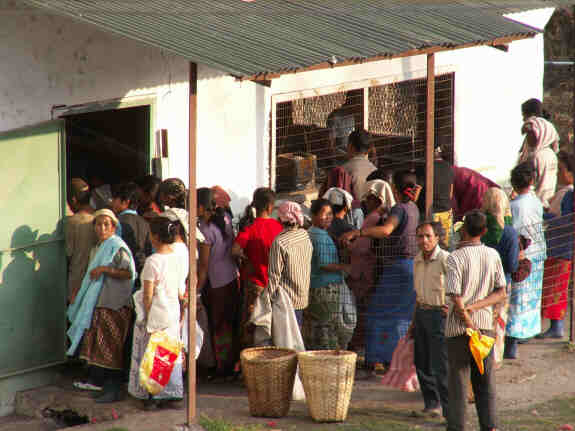
|
Tea pickers bringing in the afternoon's
pickings to the tea factory at Glenburn. |
Lunch was set out on a table by a pavilion in the garden below the bungalow and Mrs Neena Pradhan the guest services manager, three of the guests and I were served a succession of delicate and delicious vegetable dishes all grown on the estate, including a Nasturtium salad complete with the flowers. After lunch the three guests and I went for a gentle walk through the plantation where the guide (who had tended the gardens at Glenburn for 40 years) pointed out the different kinds of tea bushes, as well as a coffee bush, lemon grass, orchids and various other exotic plants. Then it was time to go back to Darjeeling; it cost 65 dollars but it was a really lovely day.
In Darjeeling I came back to reality, having to go to the ATM to get money for Sheila's purchases of the day (several pashminas)! In the small park at the top of Chowrasta we found an illuminated musical fountain playing and stopped to watch it for a while. We had booked a table at the Park restaurant again, but we were so late getting there that they had given it away and the rest of the restaurant was full with a party having a celebration for someone's graduation. We looked so disappointed that they sat us in the 'takeaway' waiting area, found a table from somewhere and brought it over, plonked a heater next to us and we had another delicious meal, including several 'freebies' that they brought over from the big party's buffet!Sat 18th. We caught the Darjeeling Himalayan Railway, better known as the 'Toy Train', to take us from Darjeeling in the mountains all the way down to the plains. The tiny, narrow-gauge railway is itself a Unesco listed monument, and it was great fun winding to and fro down the mountains, criss-crossing the road and holding up the traffic. For enthusiasts, they seem to use diesel locomotives for the daily train all the way, and steam trains for the shorter tourist runs. Also, the seats in first class face backwards all the way down and there is nowhere to turn the train round so you face forwards on the way up. However, going backwards did not worry us because we spent most of the journey leaning out of the window waving at people. We pottered down the mountain at about 10 km per hour, then when we reached the plains we seemed to pick up speed, until we noticed that there were people on pushbikes overtaking us!
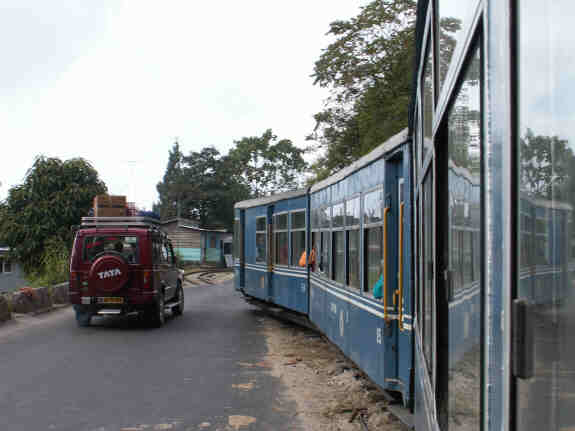
|
The 'toy train' criss-crosses the
road on its way down from Darjeeling, holding up the traffic at every turn.
|
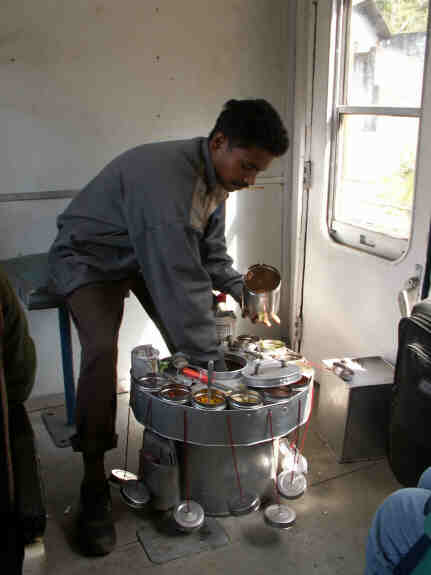
|
Lunch on the toy train - a puffed
rice seller, selling a mixture of rice, chillies, onions, sweecorn, etc.
wrapped up in a paper cone. |
Having left Darjeeling at 9:15 we finally arrived at New Jalpaiguri about
6pm and went to see if our waitlisted tickets to Calcutta had turned into
a firm booking. We were directed to the TC - ticket collector's office where
he first told us to come back later when he would know the situation, then
when we went back he wrote on our ticket 'one confirmed, one waitlisted'.
He told us to get on the train where the TTI (train ticket inspector) would
sort it out for us. We sat on our one bunk in the four-berth sleeping compartment
and gradually the three other people turned up, then the ticket inspector
came, looked at our tickets and said don't worry, he would sort it out. After
a while the train started moving so at least we weren't going to be thrown
off. Time wore on and the TTI never came back so I went in search of him
but he said sorry, the train is completely full so you will have to sleep
two in a bed. Nonplussed I went back to our compartment but the other chaps
with us said it was perfectly normal, they had done it many times because
the trains get so full. We got an extra pillow from the cabin attendant and
lay head to toe on the berth which was surprisingly wide, and actually it
was quite cosy. We slept as well as we usually do on trains and the next thing
it was 7am and we were in Calcutta.
Calcutta again
Sun 19th. After a bit of a tussle with the taxi drivers at Sealdah station (there are no fixed fares unlike at Howrah station) we got an auto-rickshaw to the Fairlawn Hotel where Sam on reception and Mrs Smith welcomed us back like old friends, which was nice. After a hearty breakfast and settling into a nice room, we felt refreshed and ready for anything. However, our problems with Indian Railways were not over, because when we went to the booking office to arrange our next journeys all the trains seemed to be full for weeks ahead. We finally managed to book the daytime train to Bhubaneswar for Tuesday, but could only get wait-listed for the next stage to Hyderabad, which is a bit of a worry.
Mon 20th. Although I had not heard anything from Mr Ashim, we went to the National Library to see if he had uncovered anything that would further my research project. In fact he had, and I spent two happy hours in the dusty archives looking through termite-eaten old books and negotiating the photocopy system, which cost a fraction of a penny per sheet but required filling in 3 or 4 forms and going several times to a cash desk in a completely different building.After this we went back to the railway booking office at Fairlie Place and finally sorted out several of the train journeys that had been worrying us. Since yesterday, an 'emergency allocation' of tourist seats had become available and we managed to change our wait listings into confirmed berths. We walked back to the hotel and after a shower to cool down we started packing for tomorrow's early start, but before we had finished we received the 'summons'. We went and had gin and tonics with Mrs Violet Smith and had a lovely chat about the days of the British in Calcutta and her travels all over the world, interspersed with her saucy Army jokes. Guests and visitors were coming and going through the Fairlawn's lobby, still one of the great meeting places of Calcutta, and Violet invited Michael, a guest from Germany but living in Scotland, to join us, and proceeded to entertain us with stories of the time she and her husband lived near Hamburg. Then we went with Michael to see the other side of Calcutta night life at the Princess Bar where the food was still great. We finished off with a coffee at a small café opposite the hotel, taking chairs out onto the street to watch the city shut down for the night. Who would have thought Calcutta would be so much fun?
Tues 21st. Up before dawn, we went to Howrah railway station to catch the Dhauli Express 'up' train to Bhubaneswar. We were in 'seat class' in a comfortable air-conditioned carriage and it was a pleasant ride, although we had to change seats because our window was blackened out and we couldn't look at the view. There was no shortage of food and tea-sellers going up and down the train and we had omelettes for breakfast. In Bhubaneswar we got a taxi to the bus station (50 rupees), a bus to Puri (60 kilometres, 25 rupees each) and an autorickshaw to the hotel we had chosen (20 rupees), all instead of a taxi all the way for 550 rupees. It was a fun ride and the bus was surprisingly comfortable for the 2-hour trip - there were padded seats and we had two of them, and nobody tried to squeeze onto our seats so there was plenty of room.
The 'Z' Hotel in Puri should have been great, it's a former Maharajah's palace in sight of the sea with huge rooms for 6 pounds a night, but it was so mosquito-infested we were rather put off. We went for a walk along Chakra Tirtha Road which is the 'travellers street' of Puri with restaurants, hotels, internet cafés, etc, and walked down to the Pink House hotel where we had a beer in their bar on the beach. Unfortunately the rooms in their hotel are like cells, but just behind it was the Sea Queen Inn, a new, clean 3-storey hotel where we immediately booked a top floor room with a balcony overlooking the sea for tomorrow. Back on the main street we went to the Garden restaurant and had a fantastic meal of two HUGE tiger prawns, Tuna chilli, rice, raita and a beer. It was incredible value for 6 pounds but the manager told us ours was the largest bill he'd presented in the whole year!Wed 22nd. We slept well under our mosquito net in the 'Z' hotel and the room looked good in the morning light, but as soon as we opened the door a cloud of mosquitos flew in so we moved to the Sea Queen Inn, where our room had a fabulous view of the waves breaking on the beach and the fishermen mending their nets. After settling in we found a cycle-rickshaw man to take us on a tour of Puri. We went to the Juggernath Temple, one of the four holiest Hindu sites in India. The temple is not open to non-Hindus and the view of it from the roof of the nearby library was interesting, but what was really fascinating was the hubbub in the street outside, which was a seething mass of street stalls, bicycle vendors, rickshaws, beggars and holy cows. We wandered about in it for some time then went down to the 'Marine Parade' that runs beside the western end of the seafront at Puri. Right at the far end of the parade is a wonderful hotel that someone had recommended called 'Hans Coco Palms', which was beautifully decorated and set in lush gardens around a swimming pool. We would have liked to stay there but it is a long way out of town and the view from our room at the Sea Queen was better, so we rickshawed along the parade past all the hotels where people from Calcutta come for their holidays and back to the eastern beach which is the travellers hangout. Sheila indulged in yet another beauty treatment, facial and hairdo (she said the sun had dried out her face and hair) then we relaxed on our balcony with a beer watching the sun set over the beach, and in the evening we went for more huge tiger prawns at the Garden restaurant. I think the manager will be able to retire on the proceeds of our dinners.
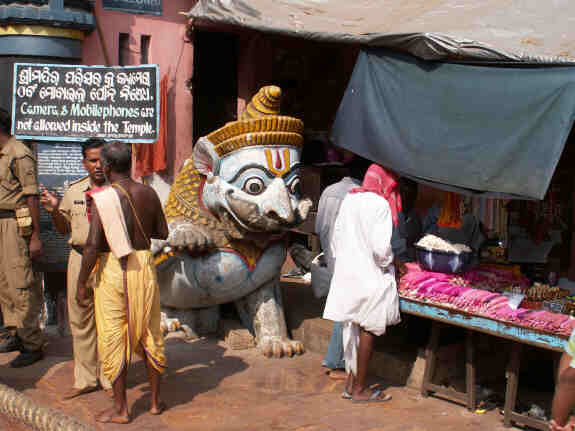
|
A guardian at the gate of the Juggernath
temple in Puri. |
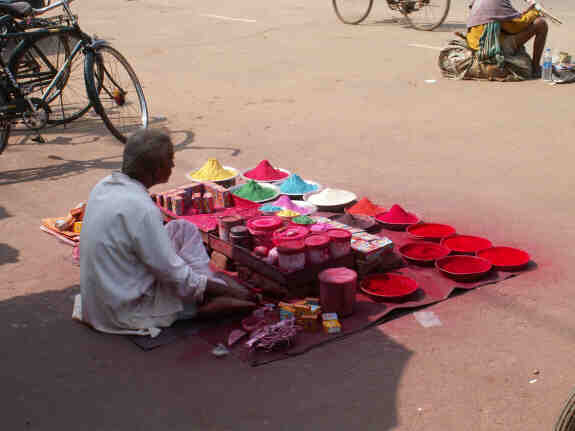
|
In the street bazaar outside Juggernath
temple, Puri. |
Thurs 23rd. We woke to a nice sunrise, fishing boats drawn up on the beach in front of our hotel and the fishermen working on their nets. We got an autorickshaw (three-wheeled, open-sided 'tuk-tuk' with a motorbike engine) for the 35 km ride to Konorak where the sun temple, an elaborately carved semi-ruin built in the 13th century, was magnificent. An autorickshaw was probably not the best way to travel there because it was very slow and the buses kept zooming past us, but it did mean we could stop to take photographs of the bullock carts and the monkeys whenever we wanted to.
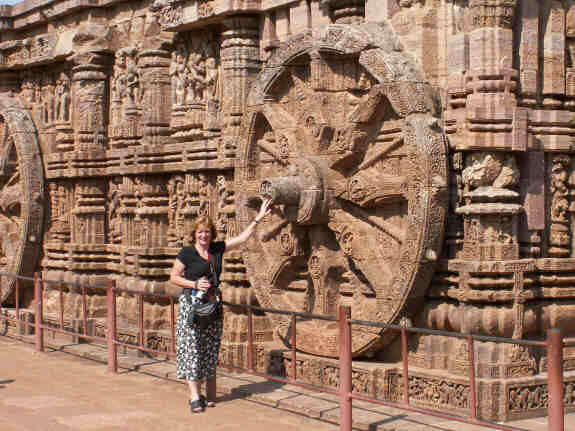
|
Konorak temple is carved to represent
a huge stone chariot. |
As sunset approached we sat on our balcony with a couple of beers again admiring the view and enjoying the ambiance, then we set off in a cycle rickshaw to the other end of Marine Parade to see the 'Puri Beach Festival'. The stage was set out on the sands with rows and rows of plastic chairs facing it and we sat near the back listening to over-amplified musicians singing songs we couldn't understand, until someone insisted that we move right to the front. We soon found out why, as hordes of film crews descended on us shining bright lights in our faces while eager interviewers queued up to ask us the same questions over and over again. I'm not sure what answers they expected but however enthusiastic we tried to sound, they seemed disappointed. As soon as we could decently get away we went down the parade to where the 'beach market' was in full swing, with a little fairground where we had a ride on a rather rickety but very fast big wheel, countless stalls all selling garish souvenirs for the Bengali tourists and a row of food stalls where we tried dishes of spicy beans, dishes of noodles and a tea, which were all very good.
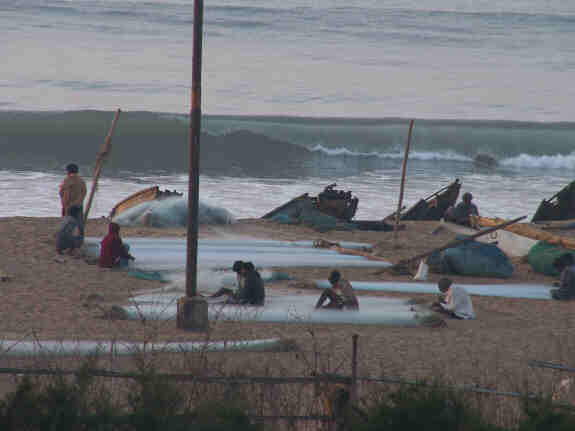
|
Fishermen mending their nets on the
beach in Puri. |
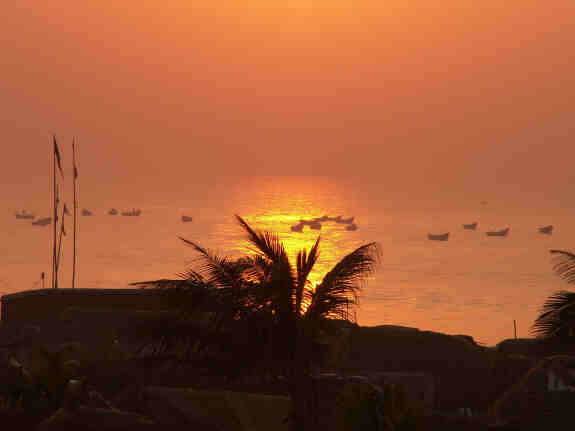
|
Sunset at Puri beach, from the balcony
of the Sea Queen Inn. |
Fri 24th. Rather than mess around we booked an Ambassador car to take us from Puri back to Bhubaneswar (550 Rupees) and also for the tour of the temples when we arrived there (200 Rupees). We waved goodbye to all the people we knew as we drove down Puri street - shopkeepers, rickshawmen and restaurateurs - then had a comfortable ride to Bhubaneswar. A few km before we got there we diverted off to see the 'Peace Pagoda' on Dhauli Hill, a huge white monument with a couple of small shrines in it, then in the town itself we visited four temples including Mukteswar Mandir, which had wonderfully detailed and elaborate carvings all over the outside. Then the driver took us to the Sambit Palace hotel which was comfortable and conveniently near the railway station.
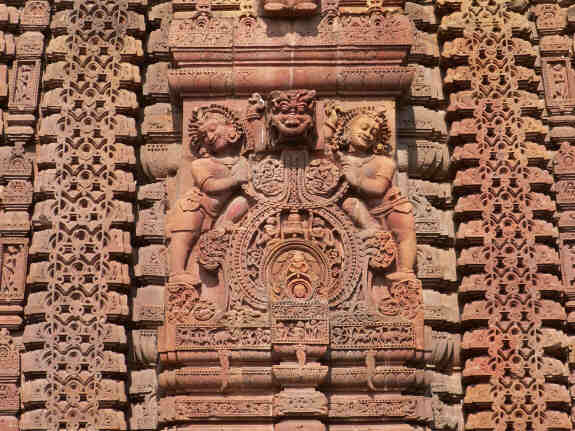
|
A small part of the elaborate carvings
on the Mukteswar Mandir in Bhubaneswar. |
In the evening we had a walk round but there didn't seem to be much to see in our part of town, so we bought a couple of beers from an off-licence because the hotel is 'dry' and retired back there for a light dinner.
Click here to see the rest of our journey,
from Hyderabad to Goa and Bombay.